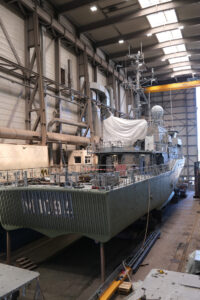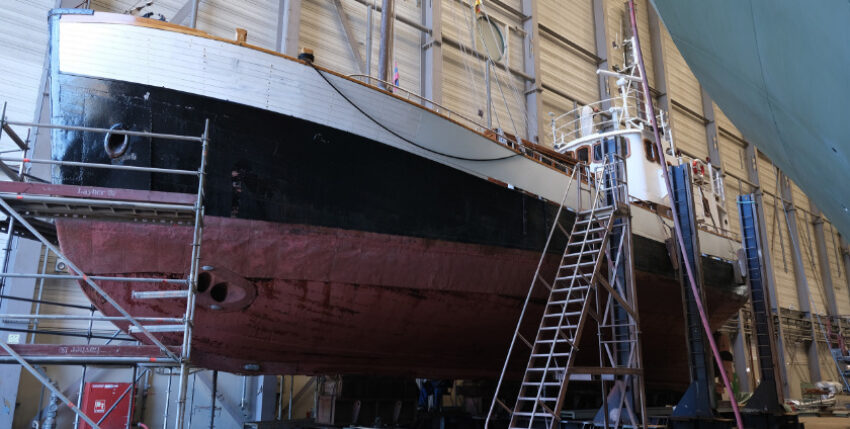With ideas, creativity and passion, Tamsen Maritim has conquered its place in the German shipyard landscape. A visit to the Warnow.
Shipyards have always been exciting. Reports therefore like to start with the history. Stories then deal with traditions and building numbers, legendary classes and old craftsmanship. Not so with Tamsen Maritim. Although the Rostock-Gehlsdorf site can be traced back to 1850, it has little to do with what you find today. There are no busts of founders, no oil paintings of old schooners and certainly no collections of brass or rigging frippery. The facility is almost new and radiates planning foresight, no old bricks with blocked corners that reflect the shipbuilding of several decades, but a fresh, tidy German shipyard industry. The distances from reception to the boss, from the meeting room to planning and from all the offices to the halls are very short. There is no sense of distance, either physically or personally. And the welcome is just as approachable, with no ties or airs and graces. The first glance is at detailed plans on the walls and countless customer pictures with dedications. In between, your gaze always wanders towards the water, which encourages creativity.

We are virtually inundated with information about projects and ideas. And Christian Schmoll, Managing Director since 2009, has a seemingly inexhaustible supply of them. Even as a boy, he says, he only had ships on his mind, much to the chagrin of his parents. Everything could wait, except that. And he has retained this enthusiasm, is passionate about his project ideas, talks about his passion almost in a whisper, jumps between facts and assessments and does not hide his pride in his shipyard and his employees at all. "Because we can do everything ourselves," he explains. The former ship's safety officer in the navy, locksmith and engineer looks back on experience at major German shipyards and has clearly found his purpose with entrepreneur, luxury sports car dealer and helicopter pilot Heiner Tamsen.

How did this come about? In 1994, the shipyard Abeking & Rasmussen from Lemwerder and Meyer Werft from Papenburg founded A&R Neptun Werft on the site of the former Max Rohde shipyard in Gehlsdorf. To date, maintenance and repair work has been carried out on more than 1200 yachts, boats and ships, in particular for the German Navy and the öAG, the public client. The technology in the shipyard area with its traversing systems still shows today for whom it was conceived. Among other things, there is a movable pier system especially for speedboats. In the first expansion phase, more than 23 million euros were invested to advance the shipyard, for example by building a ship lift with a capacity of up to 1500 tonnes. In the second expansion phase up to 2006, 38 million euros were spent on enlarging the production halls to 24,000 square metres, including the largest five-axis CNC milling machine in Europe for large plastic components. The two independently operating milling gantries are designed for components up to 73 metres long and 13 metres wide. In October 2009 - the economic crisis left its mark - the current namesake took over the shipyard. The company's objective is the construction and repair of government and specialised ships. As an aside, it should be noted that the Gorch Fock training mast for the Mürwik Naval School, which was built in 2012, was also constructed here.
It is not without reason that the shipyard brochure shows a group picture of all employees: 130 people work here in production, construction and design, with up to 16 trainees on board at any one time - thus taking precautions against a shortage of skilled labour as best they can. Schmoll knows his employees, he knows exactly who has which special skills and knowledge and which experienced people he has in his team. He is worried because the generation of specialists will slowly retire after the reunification. For him, these are not just jobs, but valuable skills that are not interchangeable.
In addition to the maintenance and repair of naval and government vessels, Tamsen Maritim also provides services for offshore wind farm supply vessels. This includes the construction of moulds for the manufacture of rotor blades for wind turbines. This is a broad portfolio, and the tour through the busy halls bears witness to the variety of orders. You are amazed at what you can see. In every hall, in every space, in every corner, a different project is being worked on. A harbour tug, the Ex-Ensdorf training minehunter from the naval technology school, a DGzRS cruiser, a tourist ship and, on the edge, a traditional old fishing boat being calfed by the increasingly rare guild of old wooden shipbuilders. A heart for shipbuilding tradition obviously takes precedence over the idea of modernity and profitability here.
Around 60 small and medium-sized ships are serviced and maintained each year. In addition to the maintenance of government and passenger ships, sea rescue cruisers, tugboats and German Navy units, the company also builds new vessels: currently two patrol boats that have been ordered by the General Customs Directorate and are intended for use in the Wadden Sea. The aluminium hulls, each 23 metres long, have a draught of just 1.20 metres. At low tide, the boats can fall dry; fins on the underbody keep the vessels laterally stable. They are each equipped with two 880-kilowatt engines. "With their exhaust gas purification system, the units fulfil the strict limits for ship emissions," says Schmoll. And: "For the first time in 20 years, watertight ships are being built in Germany again."

As a sad memorial to missed planning and premature regeneration, the German Navy's multi-purpose tug Wangerooge stands far away from the halls on the Helgen in a matt green colour. While large parts of its technology were dismantled and waiting to be refurbished in the hangar, the decision was recently made to decommission it. There was probably not much left to save, but we don't know exactly what. Anyone who knows Christian Schmoll a little can see his disappointment, especially with the communication and the process. But the professional doesn't utter a word of criticism - as an active volunteer in the Reunion Marine association, he lives the solidarity of the blue scarf.
What are his plans, I want to know? He has many of them ready, but essentially he wants to repair, maintain, construct and rebuild: "If you can repair, you can also build. It doesn't work the other way round," he says with conviction. And as if to prove it, he outlines his visions of future mine defence, of possible applications for plastic parts on naval vessels and of a product family for government ships. What is important to him is a high standard of quality, which he not only demands of himself, but which he sees as a general strength of German shipyards. When asked which construction project is particularly close to his heart, he answers spontaneously: a combat boat for the German Navy. His concrete idea of a future combat boat is the SMK 17, a counter-design to the Swedish and Finnish designs. He draws a 45-knot, 20-tonne vessel for the naval battalion, which can be airlifted by the Airbus-built A 400M military transporter and flexibly adapted to the requirements of special and specialised forces.
The fact that there are already systems available on the market spurs him on. The "Team Germany" was formed for this project with the companies Plath, Hensoldt and Hagenuk. A prototype has not yet been built, but according to Schmoll, the plans are ready for construction. The concern of the shipyard industry that, despite the categorisation of naval shipbuilding as a key technology, orders and added value could migrate abroad due to availability and therefore speed in the sense of the new Procurement Acceleration Act, is also shared on the Warnow. Nevertheless, Tamsen Maritim is already building two workboats for the German Armed Forces. Due to simultaneous production times in Gehlsdorf, the 20 metre long STS boats (security, transport, towing: see marineforum 5-22) are currently being produced in cooperation at the SET Tangermünde shipyard on the Elbe. And Christian Schmoll is getting serious: the aim is to develop and build special ships up to 50 metres in length, for which he has expanded the design team to 15 employees.
A day like this leaves an impression: You have touched steel and aluminium, smelled welding wire and heard the echo of tools in large halls. It's hardly surprising that all you can think about for a while afterwards is ships.
Holger Schlüter










